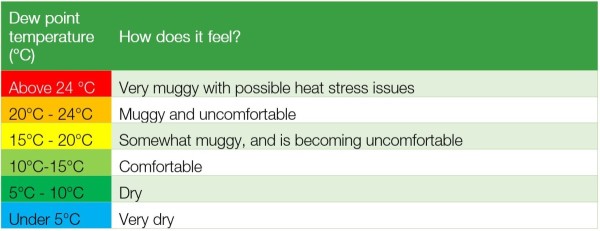How Does Dew Point Relate to Comfort and Humidity?

Have you done your dew diligence?
If you’ve ever checked the weather forecast, odds are you’ve encountered dew point before. You probably have an inkling about what it means; something to do with when dew forms, and you’d be right. But there’s a lot more to dew point than that. Dew point can tell you a lot about comfort, as well as understand humidity and evaluate indoor condensation. But how exactly does dew point relate to comfort and humidity?
What exactly is dew point?
As we’ve covered in a previous blog, air can ‘hold’ more water when it’s warm and less when it is cold. If you need a refresher on this, as well as the concepts of absolute and relative humidity, we recommend giving it a read first: https://www.smartvent.co.nz/ventilation-makes-your-home-less-humid/.
As the air gets cooler, relative humidity (RH) goes up despite the absolute humidity staying the same. Eventually (depending on the absolute humidity), the air will become cold enough that it cannot ‘hold’ any more water, this is called dew point.

Diagram explaining dew point using cups of water
But what if the temperature goes below dew point?
It’s a bit like what happens when you pour water into an already full glass. The water overflows, and everything nearby ends up wet.
When the air cannot ‘hold’ any more water (when it’s at 100% RH), and it continues to get colder, moisture in the air begins to condense. This causes water droplets to form in the air which is usually seen as either fog, rain, or condensation. A home’s inside temperature often naturally falls below dew point, especially during the night.
Eventually (if the temperature drops low enough) the water will begin to freeze, which can be seen as either frost or snow. This temperature is called the frost point.
How does dew point relate to comfort?
Dew point is often a better indicator of comfort than relative humidity percentages. RH% can mean different levels of comfort throughout the year, whereas dew point is a consistent level of comfort all year round. Why is this?
High humidity on a cold day is fine, but high humidity on a hot day can be unbearable. This is because humans rely on evaporation (sweating) in order to cool down and be comfortable. The hotter it is, the more you sweat, but if the air is already close to saturation (near its dew point) then it’s much harder for your body to cool itself down, which is uncomfortable.
To estimate comfort using relative humidity you need both the RH% AND the days temperature. On the other hand, you only need the dew point temperature to get some idea about how comfortable the day will be. This is due to the fact that ambient outdoor temperatures can’t fall below dew point, so you’ll always have some indication of how warm the day will be.
Still feeling a little lost?
To put things into perspective, it can be helpful to understand what a comfortable dew point is. Here’s a helpful guide on how different dew points might feel for an average person:

Source: Bureau of Meteorology (Australia). https://media.bom.gov.au/social/blog/1324/feeling-hot-and-bothered-its-not-the-humidity-its-the-dew-point/
These numbers are based off the Australian climate, but they are close enough to use for NZ. Essentially, between 10°C to 15°C is a comfortable dew point for New Zealand.

How does dew point relate to humidity? Condensation.
We all know that when an object like your window or a glass of water is cooler than the nearby air condensation will begin to form on it.
Why? When air touches the cool object, it begins to transfer the temperature from the object into the air. This eventually lowers the air’s temperature below the dew point. Once the temperature falls low enough, water droplets will condense and form on the surface of the object creating the mist effect condensation is known for.
Where does ventilation fit in with dew point?
Good ventilation helps prevent your home’s inside air from reaching dew point and condensing on surfaces like windows. A SmartVent Home Ventilation system can accomplish this by using the outdoor air to reduce the humidity inside your home. Less humidity means that the air needs to get colder before it reaches dew point.
SmartVent home ventilation systems with humidity sensing will respond automatically to the change in temperature, and when the humidity inside your home reaches a certain threshold, so condensation becomes a thing of the past*.
Want to take care of humidity and condensation? Book a free home assessment now!
*While ventilation with good outdoor air lowers dew point (humidity) if the surface temperatures inside your home get too cold and drop below dew point, condensation will still form. This is why in some circumstances we recommend improving glazing, insulation, and using your preferred heating solution, combined with ventilation. And in extreme local atmospheric conditions a dehumidifier. However, for most homes ventilation will be sufficient.